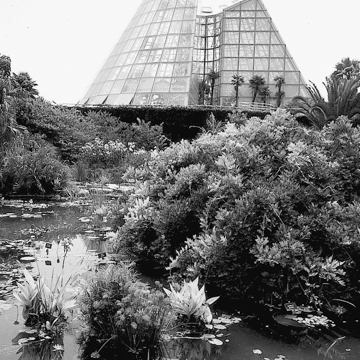Two very different architectural designs are juxtaposed at the botanical gardens. The larger of the two is the Lucille Halsell Conservatory by Ambasz. It looks like something from a science fiction film with its partially buried mass of limestone and concrete, out of which rises a series of truncated and fragmented conical glass forms.
The other building of note, the Sullivan Carriage House, is from another era. Designed by Giles in 1895, it was disassembled and moved here from downtown in the late 1980s to save it from destruction. The splendid Richardsonian Romanesque stonework is still intact, but the recent metal roof makes the building look a little too new and a little out of place in its thirty-three-acre garden setting.
Gardens planted in the low hills of Ludwig Mahncke Park reflect three native Texas regions. In the center of the park the gardens are fashioned after the Hill Country/Edwards Plateau, in the park's northern side after east Texas, and on its eastern side after southwest Texas.


